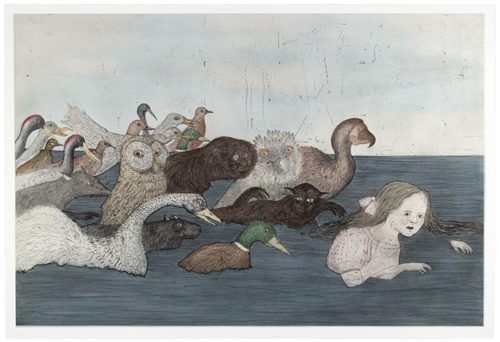Kiki Smith is often inspired by fairytales and stories in her work. Pool of Tears II takes its inspiration from Lewis Carroll’s Alice in Wonderland and from Carroll’s original manuscript and John Tenniel’s original illustrations of the story.
In Pool of Tears II Alice, having shrunk to the size of a mouse, falls into a pool of the enormous tears she herself had cried when, just before, she found herself growing uncontrollably to the ceiling.


As she said these words her foot slipped, and in another moment, splash! she was up to her chin in salt water. He first idea was that she had somehow fallen into the sea. […] However, she soon made out that she was in the pool of tears which she had wept when she was nine feet high.
[…] ‘I wish I hadn’t cried so much!’ said Alice, as she swam about, trying to find her way out. ‘I shall be punished for it now, I suppose, by being drowned in my own tears! That will be a queer thing, to be sure! However, everything is queer to-day.’ Just then she heard something splashing about in the pool a little way off, and she swam nearer to make out what it was: at first she thought it must be a walrus or hippopotamus, but then she remembered how small she was now, and she soon made out that it was only a mouse that had slipped in like herself.
[…] It was high time to go, for the pool was getting quite crowded with the birds and animals that had fallen into it: there were a Duck and a Dodo, a Lory and an Eaglet, and several other curious creatures. Alice led the way, and the whole party swam to the shore.
– Excerpt from Alice’s Adventures in Wonderland by Lewis Carroll (London, England: Macmillan Publishing Co., 1865)


The Nursery “Alice” (London: Macmillan Publishing Co., 1890)
Kiki Smith is not the only artist to have created works inspired by Carroll’s story. Artists such as Max Ernst, Peter Blake, Francesca Woodman and Anna Gaskell have been fascinated by Alice’s adventures through the rabbit hole. Alice’s swim in a pool of her own tears, surrounded by a menagerie of everyday and fantastical creatures, is a particularly surreal moment. It is perhaps unsurprising that the Surrealist artist Salvador Dalí produced a lithograph depicting it. In 1969, Random House publishers commissioned Dalí to produce an exclusive edition of Alice in Wonderland. Among the twelve lithographs he made for it was a depiction of the Pool of Tears.

Alice’s changing size throws off her sense of identity; she no longer knows who she is and is troubled by the thought that she may in fact have become someone else. She is reduced to the size of a mouse, and the mouse becomes her equal, if not – when he scolds her – her superior. In Carroll’s story, the young Alice’s naive arrogance is repeatedly challenged by the magical things that happen to her and fantastical characters she encounters. She learns the importance of the mutual respect between herself and the creatures of wonderland; between humanity and nature. As Kiki Smith says: ‘We are interdependent with the natural world… our identity is completely attached to our relationship with our habitat and animals.’
See Pool of Tears II until 19 January 2020 as part of our exhibition with Kiki Smith: I am a Wanderer.
Discover the work online in our virtual Kiki Smith exhibition here.
